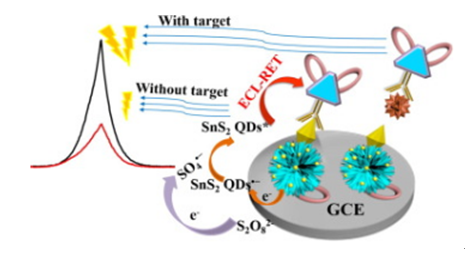Welcome to College of Chemistry, Chemical Engineering and Materials Science of Soochow
University
Electrochemiluminescence resonance energy transfer system between nontoxic SnS2 quantum dots and ultrathin Ag@Au nanosheets for chloramphenicol detection
Jia Chen, Jieru Zheng, Kang Zhao, Anping Deng*(邓安平), Jianguo Li*(李建国)
The Key Lab of Health Chemistry & Molecular Diagnosis of Suzhou, College of Chemistry, Chemical Engineering & Materials Science, Soochow University, Suzhou 215123, China
Chemical Engineering Journal 392 (2020) 123670
Herein, an efficient electrochemiluminescence energy resonance transfer (ECL-RET) system was first applied in an immunosensor for the detection of chloramphenicol (CAP). SnS2 quantum dots (SnS2 QDs) has an extremely narrow electrochemical emission spectrum, which was used as donor. Compared with conventional quantum dots, toxic-element-free SnS2 QDs exhibit superior environmental friendliness and biocompatibility. Ultrathin Ag@Au nanosheets (Ag@Au NSs) was selected as acceptor due to its excellent structure and controllable UV-vis absorption range. Furthermore, ZnO nanoflowers (ZnO NFs) was employed to modify the electrode surface to provide stable luminescent environment and support more SnS2 QDs. Taking these advantages, the absorption spectra of Ag@Au NSs and the ECL emission spectra of SnS2 QDs are highly matched which ensures the occurrence of ECL-RET. When the CAP analyte were absent, Ag@Au NSs was immobilized on the electrode, and its ultrathin thickness effectively shortens the path of ECL-RET to produce the weak ECL intensity. Inversely, CAP analyte would compete with coating antigen for the certain amount of antibody to remove excess Ag@Au NSs and cause relatively high ECL intensity. As a result, the proposed immunosensor performed satisfactory sensitivity with a wide linear range from 0.005 to 1000 ng mL−1 and a low detection limit (1.7 pg mL−1).

链接:https://www.sciencedirect.com/science/article/pii/S1385894719330852